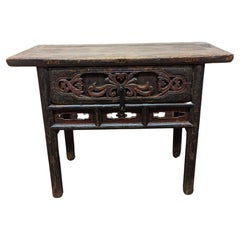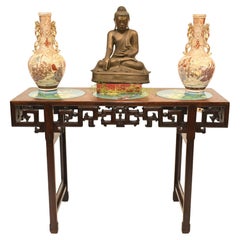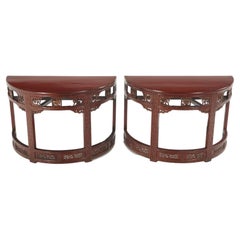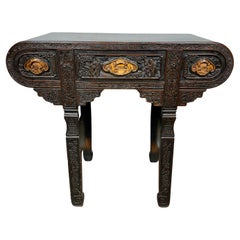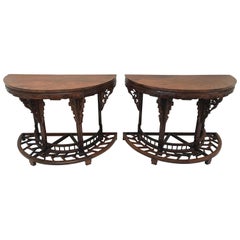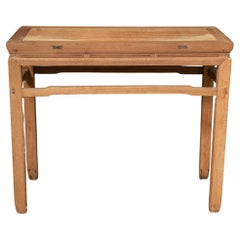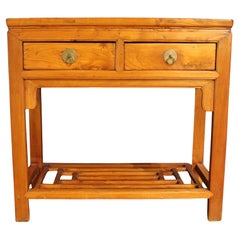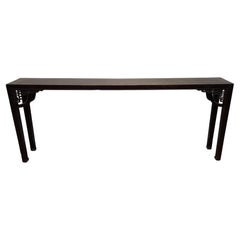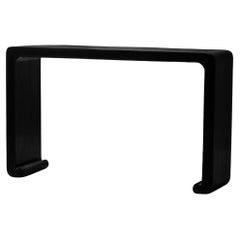Antique Chinese Console
Early 19th Century Antique Chinese Console
Elm
1920s Antique Chinese Console
Hardwood
1880s Chinoiserie Antique Chinese Console
Wood
1920s Chinese Chinese Export Antique Chinese Console
Rosewood
Late 19th Century Chinese Antique Chinese Console
Elm
Early 20th Century Chinese Other Antique Chinese Console
Teak
19th Century Chinese Qing Antique Chinese Console
Metal
Early 1800s Chinese Qing Antique Chinese Console
Elm
19th Century Chinese Antique Chinese Console
Wood
1870s Chinese Antique Chinese Console
Elm
Mid-19th Century Chinese Qing Antique Chinese Console
Elm
Late 19th Century Chinese Ming Antique Chinese Console
Wood
Late 19th Century Chinese Qing Antique Chinese Console
Wood
15th Century and Earlier Chinese Ming Antique Chinese Console
Brass
Mid-19th Century Chinese Antique Chinese Console
Brass
Early 19th Century Chinese Qing Antique Chinese Console
Elm
Late 19th Century Chinese Ming Antique Chinese Console
Metal
19th Century Chinese Antique Chinese Console
Elm
19th Century Chinese Qing Antique Chinese Console
Wood
19th Century Chinese Antique Chinese Console
Wood
Late 19th Century Chinese Ming Antique Chinese Console
Elm
1890s Chinese Qing Antique Chinese Console
Elm
Late 19th Century Chinese Chinese Export Antique Chinese Console
Elm
19th Century Asian Antique Chinese Console
Brass
19th Century Chinese Qing Antique Chinese Console
Elm, Lacquer
Early 20th Century Chinese Qing Antique Chinese Console
Elm
Early 20th Century Chinese Antique Chinese Console
Wood
Early 20th Century Chinese Qing Antique Chinese Console
Wood
Early 20th Century Chinese Other Antique Chinese Console
Wood
Early 1900s Chinese Qing Antique Chinese Console
Hardwood
Mid-19th Century Chinese Chinese Export Antique Chinese Console
Walnut
19th Century Chinese Chinese Export Antique Chinese Console
Wood
18th Century Chinese Antique Chinese Console
Elm
19th Century Chinese Antique Chinese Console
Elm
Early 19th Century Chinese Antique Chinese Console
Hardwood
1880s Chinese Qing Antique Chinese Console
Elm
Late 18th Century Chinese Antique Chinese Console
Wood
Late 19th Century Chinese Chinese Chippendale Antique Chinese Console
Marble
Late 19th Century Chinese Qing Antique Chinese Console
Wood
19th Century Chinese Antique Chinese Console
Hardwood
Late 19th Century Chinese Antique Chinese Console
Marble
Mid-19th Century Chinese Qing Antique Chinese Console
Walnut
Late 19th Century Chinese Chinese Export Antique Chinese Console
Elm
Mid-19th Century Chinese Chinese Export Antique Chinese Console
Wood
Late 19th Century Chinese Antique Chinese Console
Wood
18th Century English Chinoiserie Antique Chinese Console
Mahogany
1890s Chinese Chinese Chippendale Antique Chinese Console
Wood
19th Century Chinese Chinoiserie Antique Chinese Console
Travertine
Early 1900s Chinese Chinoiserie Antique Chinese Console
Wood, Paint
18th Century Chinese Antique Chinese Console
Elm
Mid-18th Century English Chinese Chippendale Antique Chinese Console
Mahogany
Late 19th Century British Chinese Chippendale Antique Chinese Console
Rosewood
Late 19th Century Central Asian Chinese Export Antique Chinese Console
Elm
Early 20th Century Chinese Qing Antique Chinese Console
Elm
Early 20th Century Chinese Tibetan Antique Chinese Console
Elm, Pine, Lacquer
Late 19th Century Asian Qing Antique Chinese Console
Teak
Mid-19th Century Chinese Qing Antique Chinese Console
Elm
- 1
- ...
Antique Chinese Console For Sale on 1stDibs
How Much is a Antique Chinese Console?
Finding the Right Console-tables for You
Few pieces of furniture are celebrated for their functionality as much as their decorative attributes in the way that console tables are. While these furnishings are not as common in today’s interiors as their coffee-table and side-table counterparts, console tables are stylish home accents and have become more prevalent over the years.
The popularity of wood console tables took shape during the 17th and 18th centuries in French and Italian culture, and were exclusively featured in the palatial homes of the upper class. The era’s outwardly sculptural examples of these small structures were paired with mirrors or matching stools and had tabletops of marble. They were most often half-moon-shaped and stood on two scrolled giltwood legs, and because they weren’t wholly supported on their two legs rather than the traditional four, their flat-backed supports were intended to hug the wall behind them and were commonly joined by an ornate stretcher. The legs were affixed or bolted to the wall with architectural brackets called console brackets — hence, the name we know them by today — which gave the impression that they were freestanding furnishings. While console tables introduced a dose of drama in the foyer of any given aristocrat — an embodiment of Rococo-style furniture — the table actually occupied minimal floor space (an attractive feature in home furniture). As demand grew and console tables made their way to other countries, they gained recognition as versatile additions to any home.
Contemporary console tables comprise many different materials and are characterized today by varying shapes and design styles. It is typical to find them made of marble, walnut or oak and metal. While modern console tables commonly feature four legs, you can still find the two-legged variety, which is ideal for nestling behind the sofa. A narrow console table is a practical option if you need to save space — having outgrown their origins as purely ornamental, today’s console tables are home to treasured decorative objects, help fill empty foyers and, outfitted with drawers or a shelf, can provide a modest amount of storage as needed.
The rich collection of antique, new and vintage console tables on 1stDibs includes everything from 19th-century gems designed in the Empire style to unique rattan pieces and more.
- 1stDibs ExpertNovember 4, 2024To identify antique Chinese furniture, look carefully at its details. Chinese craftsmen often built furniture using mortise and tenon joinery, eliminating the need for nails and screws. If you see this type of hardware, your piece is likely not at least 100 years old, especially if the hardware still looks new and shiny. Since antique furniture was handmade, you will normally see slight imperfections, such as tool marks or slight variations in carvings. Pieces that appear completely uniform and pristine are less often genuine antiques.
When present, maker's marks can also be helpful. Research the marks to learn more about when the maker was active and producing pieces like yours. Alternatively, you can have a certified appraiser or experienced antique dealer evaluate your furniture for you.
Shop an assortment of antique Chinese furniture.  Lotus GallerySeptember 23, 2020
Lotus GallerySeptember 23, 2020The best way to know is to take it to an expert, such as an appraiser, reputable dealer or auction house, or museum
 PAGODA REDOctober 7, 2020
PAGODA REDOctober 7, 2020To determine the age of a Chinese furniture piece, look carefully at the joinery and finish. Natural expansion and contraction of the wood over time will cause a joint to protrude or retract, distorting a once-seamless fit. Antique lacquer finishes become crackled and worn over time. Areas of exposed wood, such as the underside of a table, the footrest of a chair, or the back of a cabinet should appear raw and dry compared to the finished surface. With use, the legs of tables and chairs become weathered near the bottom from precipitation and use.
Read More
20 Inviting Dining Rooms Perfectly Arranged for Entertaining
Top interior designers show — and tell — us how to create delectable spaces for hosting dinner parties.
This Alain Delon–Designed Table Is Almost as Handsome as He Was
Fans of the French film star may be surprised to learn that he had a flair for furniture with sleek lines and disco-era flash.
Uchronia’s Plant Stand Gives Pots a Pretty Perch with All the Trimmings
Like other pieces in the firm’s Candy Box collection, the cheerful limited-edition design showcases French craft.
The Ultimate Guide to Types of Tables for the Home
Whether you’re just moving in or ready to give your home a makeover, our guide will give you pointers on tables that are fitting for every room, nook and hallway.
Is Lionel Jadot the Willy Wonka of Upcycled Belgian Design?
From his massive collaborative workshop in a former paper factory, the designer concocts funky furniture from disused materials, as well as luxe hotel interiors like the new Mix Brussels.
Inspired by the Cosmos, Sandra Nunnerley’s Nova Table Has a Futuristic Feel
The designer’s innovative use of an unexpected material gives this console a lift.
This 19th-Century Gilded Desk Displays a Fanciful Kingdom in Marquetry
The stately piece brings both gravitas and whimsy to any work space.
In Guadalajara, These Luscious Side Tables Are Chiseled from Volcanic Rock
Use them as tables or stools, indoors or out.
